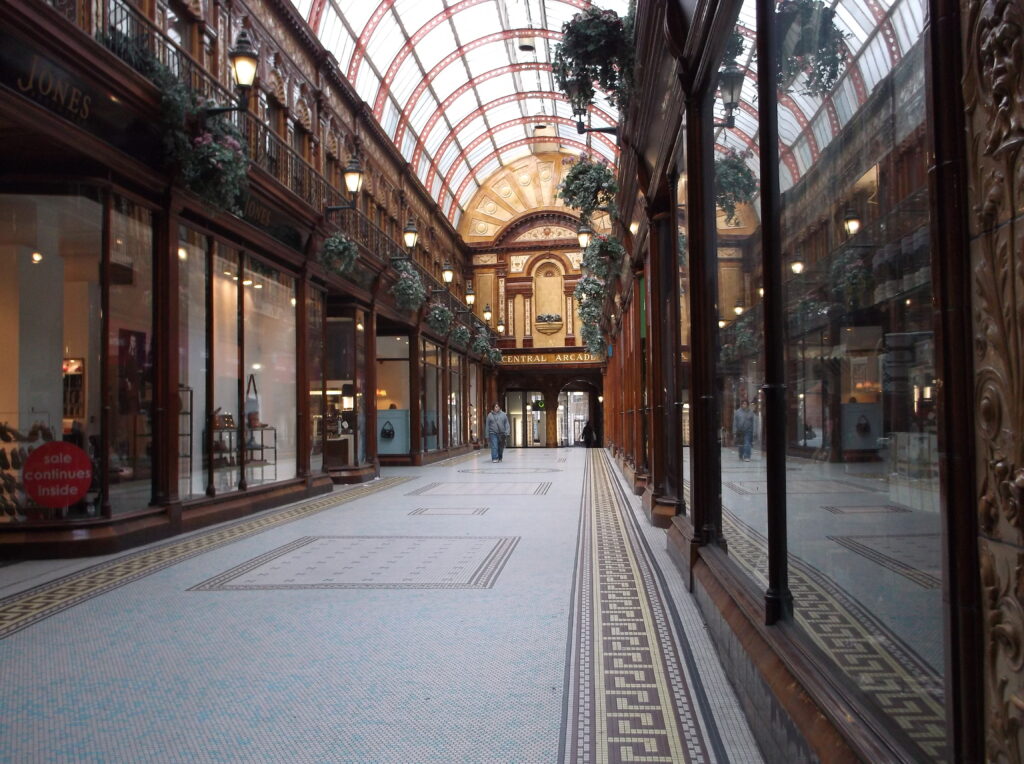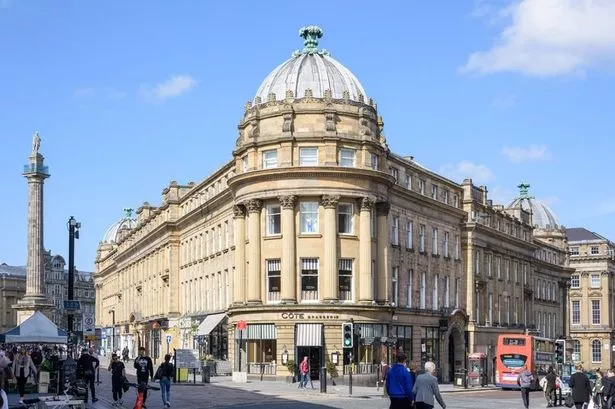Introduction
In the heart of Newcastle upon Tyne, nestled between the busy streets of Grainger Street, Grey Street, and Market Street, lies one of the city’s most cherished architectural landmarks — the Central Arcade. This beautiful Edwardian shopping arcade is not only a functional retail space but also a living piece of history, a finely preserved example of early 20th-century craftsmanship and civic pride.

With its ornate tile work, domed glass roof, and polished wood features, the Central Arcade stands as a testament to Newcastle’s commercial prosperity and its commitment to architectural beauty. More than a century since its construction, it remains a beloved destination for locals and visitors alike, offering a unique blend of historical ambience and modern retail charm.
Historical Background
The Central Arcade stands on the site of the original Central Exchange, a building erected in 1837 and designed by the famed architect John Wardle. The Central Exchange was intended as a commercial hub and social centre, with plans including a subscription newsroom, art gallery, and lecture hall. Initially, it was part of the Grainger Town redevelopment plan spearheaded by Richard Grainger and designed in collaboration with architects like John Dobson and Thomas Oliver.
The building saw various uses in its early years. By the 1870s, it was converted into a music hall and later a concert venue known as the City Concert Hall. Sadly, in 1901, a fire ravaged the building, leaving much of the interior destroyed. The exterior façade survived, but the interior had to be completely rebuilt.
The reconstruction effort resulted in the magnificent Central Arcade we see today. It was completed in 1906, designed in the Edwardian Baroque style, which was fashionable in Britain during the late Victorian and Edwardian periods. The arcade officially reopened to the public in 1906, becoming one of the most beautiful shopping arcades in the country.
Architectural Design
The Central Arcade is a three-storey, glass-roofed arcade that connects Grainger Street to Market Street, with an additional entrance from Grey Street, one of the most famous streets in the UK. The arcade runs through the centre of a grand triangular block and features a light-filled interior that combines ironwork, glass, polished wood, and richly glazed tiles to stunning effect.
Exterior
From the outside, the building presents a commanding Edwardian façade. The stonework remains from the original Central Exchange, giving the structure a sense of architectural continuity. Its Greco-Roman columns, grand arches, and intricate cornices reflect the classical influence of the Grainger Town project. Large arched windows and iron balconies hint at the building’s elegant interior.
Interior
The arcade’s true magnificence reveals itself once you step inside:
- Glazed Tilework: Rich faience tiling in cream, brown, and olive shades covers the walls from floor to ceiling. These tiles are not only decorative but were practical for easy cleaning and high durability, making them ideal for busy shopping environments.
- Wooden Shopfronts: The interiors of the retail units are framed in mahogany and glass, providing a warm contrast to the cool tiles. The meticulous joinery demonstrates the level of craftsmanship typical of early 20th-century British design.
- Iron and Glass Roof: The arcade is topped with a barrel-vaulted glass roof, supported by iron framework, allowing natural light to flood the space. The glazed ceiling adds both elegance and functionality, enhancing the shopping experience with bright, natural illumination.
- Mosaic Flooring: Intricate mosaic patterns run the length of the arcade’s floor, echoing the symmetry and detail seen throughout the structure.
- Ornate Details: Carved stonework, decorative friezes, cornices, and cast-iron embellishments can be seen throughout. Every detail, from the handrails to the signage frames, demonstrates a commitment to beauty and coherence in design.
Function and Use Over Time
Since its opening in 1906, the Central Arcade has operated continuously as a shopping and commercial space. Through the decades, it has adapted to changing times without sacrificing its historical charm.
Retail and Commerce
The arcade has housed a variety of businesses, from high-end tailors, perfumeries, and watchmakers in the early 20th century to more modern shops, including souvenir stores, fashion boutiques, and musical instrument shops. One of its most enduring and beloved tenants is J.G. Windows Ltd, a prestigious music shop founded in 1908 — just two years after the arcade opened. The shop is a landmark in its own right and is a favourite for musicians and collectors across the region.
Cultural Significance
The Central Arcade is more than a shopping passage — it is a cultural icon. Its proximity to Grey Street and Theatre Royal has made it a central part of Newcastle’s urban narrative. It has often been featured in tourist literature, postcards, photography books, and regional heritage guides.
The arcade has been listed as a Grade II listed building*, ensuring its protection and recognition as a structure of architectural and historic importance. Its continued operation is a testament to the city’s commitment to preserving its historical assets.
Preservation and Conservation
Throughout the 20th and early 21st centuries, Newcastle City Council and heritage organisations have undertaken various restoration and maintenance efforts to preserve the arcade’s structure and details. Key restoration tasks have included:
- Replacing damaged faience tiles
- Restoring and polishing the wooden shopfronts
- Replacing sections of the iron and glass roof
- Upgrading internal lighting while maintaining historical integrity
- Installing information plaques and signage to educate visitors
Importantly, conservation efforts have remained sensitive to the arcade’s original materials and techniques, making it an exemplary case of urban preservation.
Tourism and Modern Relevance
Today, Central Arcade remains a popular destination for tourists, shoppers, and architecture enthusiasts alike. It provides a quiet oasis of elegance amid the hustle and bustle of the city centre. For many visitors, it offers a nostalgic journey into Edwardian Newcastle, a time of burgeoning prosperity and refined civic ambition.
Its central location between Monument Metro Station, Eldon Square, and Grainger Market ensures high footfall, and its unique aesthetic makes it one of the most photographed locations in the city. Whether you’re a music enthusiast visiting J.G. Windows, a shopper browsing local gifts, or simply an admirer of architecture, the arcade offers something timeless and unique.
In recent years, it has also become a popular setting for photographers, filmmakers, and social media influencers, often featured in content that celebrates Newcastle’s urban charm.
The Arcade in Context
The Central Arcade sits at the crossroads of Newcastle’s architectural and commercial history. It links the neoclassical grandeur of Grey Street, the retail energy of Grainger Street, and the historical depth of Grainger Town. As such, it is not an isolated attraction but a critical component of Newcastle’s civic identity.
In the wider context of British architecture, the Central Arcade is part of a tradition of covered shopping arcades that became popular during the Victorian and Edwardian eras. Alongside examples in London (like Burlington Arcade) and Leeds (Victoria Quarter), Newcastle’s Central Arcade stands out for its exceptional state of preservation and its vibrant, continuous use.
Conclusion
The Central Arcade of Newcastle is more than just a beautiful building — it is a living monument to the city’s aspirations, creativity, and architectural heritage. Its combination of functionality, elegance, and historical continuity makes it one of the finest examples of Edwardian commercial design in the country.
Over a century after its creation, the arcade continues to enchant all who walk through it. In a fast-changing world, it remains a space where the past is not only remembered but still very much alive — resonating through its tiled walls, echoing under its vaulted roof, and reflecting in the polished glass of its windows.
As long as Newcastle values its history, the Central Arcade will remain a shining jewel in the crown of this proud northern city.

